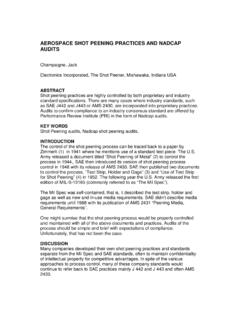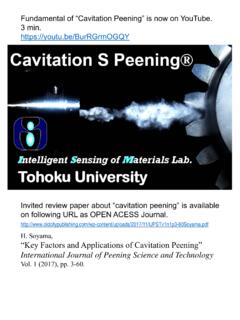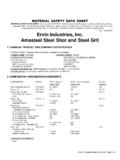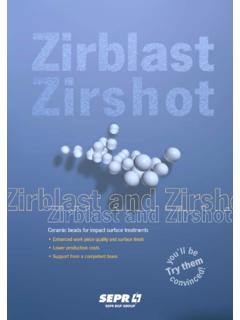Transcription of Improvement of the Heat Checking Resistance of Casting ...
1 Improvement of the heat Checking Resistance of Casting Dies by Shot- peening Tadanobu Oyama1, Yuji Kobayashi1, Toshihiro Kitagawa2, Noki Yokoi3 and Yasushi Hiraoka 1 SINTOKOGIO, LTD., JAPAN 2 Daido Amistar Co.,Ltd, JAPAN 3 Daido Steel Co., Ltd Abstract In this study, heat treatment and shot- peening conditions were examined for the purpose of improving the heat Checking Resistance of Casting dies. Nitriding was selected as heat treatment and the two-stepped shot- peening process was used to apply a residual stress after removing the compound layer generated by nitriding. By manufacturing actual die-cast products and evaluating the damage caused to the dies, it was found that the heat check Resistance of nitrided dies is much higher than that of non-nitrided ones. Keywords Shot peening , Die- Casting , heat check, Nitriding.
2 Introduction Die-cast products are widely used for automotive parts and electric appliances and manufactured with dies made of a high strength material. Cracks called heat Checking is generated on die surface by thermal fatigue caused by repeated heating by molten metal and cooling by mold lubricant. In these days, the die Casting cycle time has been shortened to reduce the cost, which has increased the thermal stress applied to die surfaces. In this study, the heat treatment (nitriding) and shot- peening combined process was examined for the purpose of improving the heat check Resistance of Casting dies. Specimens and shot- peening conditions Die specimen manufacturing method: A higher strength material should be used to prevent heat Checking . However, high strength means high hardness.
3 Dies made of a harder material are inferior in toughness and need to be toughened to some degree to eliminate the possibility of large cracks. Therefore, heat Checking should be effectively prevented by only reinforcing the surfaces and the most frequently used heat treatment at the present is nitriding. However, ordinary gas nitriding generates a compound layer with poor toughness as shown in and heat checks in this layer are known to grow to the nitrogen diffused layer. Then, we invented a process as shown in First, the surface rigidity of the material is improved by nitriding. The compound layer generated at this time is removed during the first shot- peening step. Then, the exposed nitrogen diffused layer is shot-peened. This process is called Aminit DS. Table 1 shows the first and second shot- peening conditions.
4 Specimens were shot-peened using a Sinto Kogio s gravity shot- peening machine MY-40. Table 1. Shot- peening conditions Shot- peening conditions 1st shot peening 2nd shot peening Media Alundum Amo beads Media size #150 50 m Air pressure (MPa) heat Checking test A heat Checking test was performed as a laboratory test to evaluate the heat Checking Resistance of specimens manufactured with the Aminit DS process. shows an overview of the heat check test method. Specimens were prepared as H13(SKD61, 44 HRC). The heat Checking specimens were evaluated for residual stress distribution ( ) and surface roughness ( ). The values obtained with gas sulphonitriding and salt bath nitriding are also shown for reference. According to , the compressive residual stress, approximately -1500 MPa, was observed at surfaces of specimens manufactured with the Aminit DS process.
5 For salt bath nitrided specimens, on the other hand, a compound layer generated at the surface obstructed the surface residual stress measurement. Peenig process (Aminit DS) Compound layer Remove compound layer 1st shot peening Improvement of surface roughness Additional peening effect 2nd shot peening Residual stress Sectional structure of surface of nitrided parts Base material Compound layer As shown in , the surface roughness obtained with the Aminit DS process is almost equivalent to that of unpeened specimens. In addition, the micrographs of their cut sections show that the surface compound layer has been completely removed. Results of heat Checking test shows textures of heat - Checking surfaces observed after 30,000 cycles of heat Checking test around the centers of specimens, which were subject to the highest thermal stress during the test.
6 A number of heat Checking were observed with unpeened and salt bath nitrided specimens but no heat check was visually recognized with specimens manufactured with the Aminit DS process. It is found from this fact that the Aminit DS process has a great effect to prevent heat Checking . Experimental method of evaluation of heat chek Resistance Maximum temperature: 580 C Test piece design: 58x57 x 50mm Evaluation surface High frequency heating 7s Water-cooled 3s Air blow 3s Residual stress distribution -1600 -1400 -1200 -1000 -800 -600 -400 -200 0 0 Depth (mm) Residual stress (MPa) Aminit DS Salt bath nitriding Gas-sulphonitriding Casting experiment for shot peened dies Dies were manufactured to the dimensions shown in and actually used for Casting to determine their heat Checking Resistance .
7 The following three features were incorporated into the shape of the die specimens. (1) A simple, easily testable shape simulating actual dies (2) A thick Casting with a large sectional area (aiming to raise the die temperature) (3) A protrusion beside the pouring gate (aiming to concentrate stresses at the corner) Table 2 shows details of the specimens and Table 3 shows testing ( Casting ) conditions. The die manufacturing process consists of rough machining, quenching and tempering, finishing and Aminit DS. A just quenched and tempered die and a salt bath nitrided one were also used for comparison. Table 2. Chemical composition of die material C Si Mn Cr Mo V H13(SKD61) Surface texture after experiment 1mm Unpeened Salt bath nitrided Aminit DS Surface roughness Table 3. Die Casting conditions Aluminum alloy ADC-12 Injection speed Alloy weight 600g Casting pressure 65 Mpa Alloy temperature 700 C Injection time of parting agent 3s Results of Casting experiment shows photographs of die surfaces used for 5,000 Casting cycles.
8 The heat Checking Resistance of the salt bath nitrided die seems to be slightly better than that of the unpeened one while the Aminit DS processed die has much fewer heat Checking . Discussion and Conclusions As a result of a study to prevent heat Checking on die surfaces and optimize the material and heat treatment and shot- peening conditions, a two-stepped shot- peening process has been developed where the compound layer generated by nitriding is removed by the first shot- peening step, and the surface is shot-peened by the second step in order to apply compressive residual stress. According to a heat Checking test and an evaluation of damage to the dies actually used for Casting , the newly developed process was found to have a great effect to prevent heat Checking .
9 Surface damage after experiment 10mm Unpeened Salt bath nitrided Aminit DS Pouring direction Outline of part Corner R: Die-cast part Design of die and Die-cast part References [1] T. Kitagawa and Y. Hiraoka and Y. Kobayashi, Complex surface treatment, improving heat - Checking Resistance for die Casting mold AMINIT DS , Die and Mould Technology , Vol. 25 (2010), pp 118-129. [2] S. Nakahama, Technologies to improve the Casting die life , Die and Mould Technology , Vol. 25 (2010), pp 48-51. [3] Y. Naoki and K. Inoue, Casting Technology Conference proceedings, (2008), pp 220.









